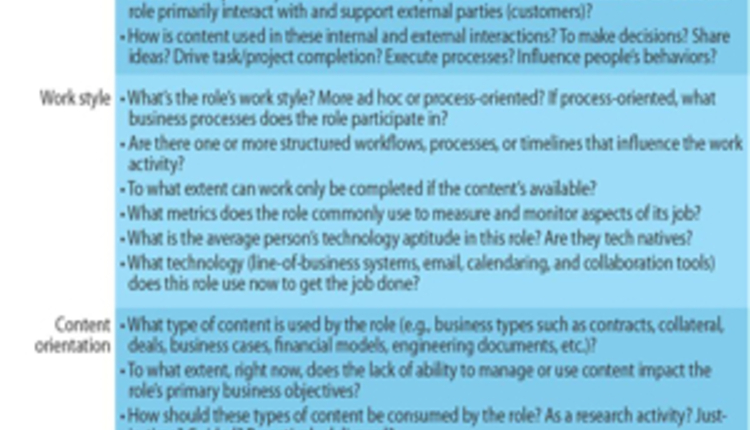Planning and strategizing in the governance framework establish the roles and responsibilities for a site as well as provide the guidelines for education, testing, change management, deployment, development and configuration — all of which is important. But enterprises must first define a clear vision for SharePoint, or else implementations will suffer from lack of experience, discipline, processes and skills sets associated with more successful IT-led ECM deployments.
Enterprises can take many options and paths with SharePoint, and any SharePoint vision must wrestle with many questions. For example, what applications should leverage SharePoint functionality versus those that require support from advanced ECM systems? Exactly who owns the information managed by SharePoint and can make decisions about policy and information rights management? Should SharePoint:
- Serve as the official system of record? Enterprises have too many repositories, each often serving as a system of record, supporting distinct departments and content types such as customer records and email. Proliferation of SharePoint sites, while better than file shares, serves to complicate consolidation efforts, and information and knowledge management (I&KM) pros must decide whether SharePoint provides a viable platform for consolidation. If not, they may choose to migrate SharePoint content to another platform for long-term retention.
- Extend beyond team collaboration and business content needs? Most enterprises have pervasive ECM needs. With SharePoint, I&KM pros often ask if they should use it to support internal applications, such as contract management or HR onboarding. Should they use SharePoint to manage content for the supply chain? Should it capture and manage workflow for invoices that support their enterprise resource planning (ERP) deployment? I&KM pros should not answer these questions solely at the department or business unit level, but base their answers on their analysis of business context — segmented content needs reflecting how people use information.
- Integrate with traditional ECM solutions? Traditional ECM systems, in addition to providing more discrete control of content, can have operational and administrative advantages. Features such as de-duplication, compression and use of less expensive storage can result in savings. SharePoint's usage of the SQL Server database stores content, such as images, as binary large objects (BLOBs). These can make for extremely large databases, which can raise administrative concerns.
- Provide workflow support? Many enterprises that Forrester has interviewed wrestle with how extensively to use SharePoint's workflow support through Window Workflow Foundation (WF). We have found that WF best suits workflow needs improving communication around a business process, with a goal not to minimize actions but actually to expand them. Enterprises attempting to use SharePoint and WF in transactional content areas where minimizing exceptions and straight-through processing reign supreme find it lacking.
SharePoint and WF provide a build environment for workflows. Traditional ECM providers and pure-play BPMS providers have created packaged workflow applications that require less customization.
When developing your SharePoint strategy, bear in mind that it lacks advanced design, modeling and automation features that are important for process transformation. Furthermore, Microsoft has yet to define a clear strategy for BPM — improvements are anything but certain.
Craig Le Clair [www.forrester.com/documentmarch] is a principal analyst at Forrester Research, where he serves information and knowledge management professionals. Download a complimentary copy of his full report (free site registration required), "Governing SharePoint In The Enterprise,•bCrLf at their website.











